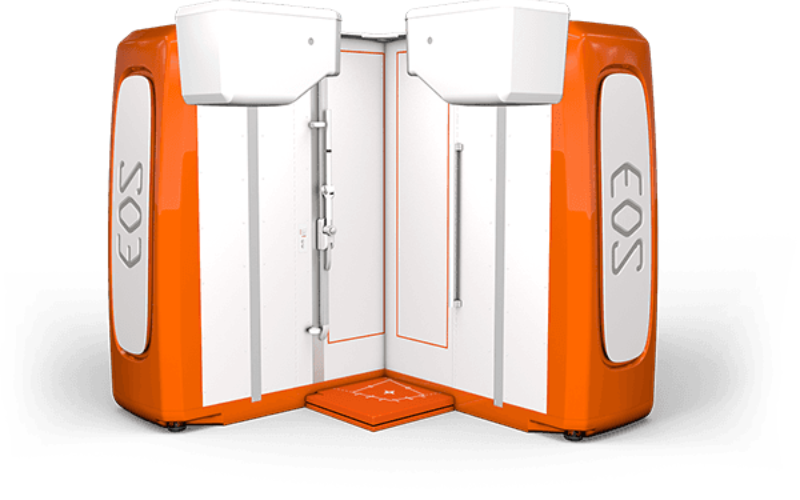NEW! On-Site EOS Imaging
At Carolina Orthopaedic & Neurosurgical Associates

What is EOS Imaging?
The EOS x-ray, known as EOSedge™, is the first technology that can make 3D images of a patient’s whole body while they are standing. The EOS scanner provides orthopedic imaging for people with back, hip, or leg problems. It also gives off much less radiation than other scanners.
This technology makes high-quality images with up to 20 times less radiation than a CT scan and nine times less radiation than a computed radiography x-ray.
How EOS Imaging Works
During an EOS exam, the person stands or sits up straight in a special scanning room. Two very narrow X-ray beams, one vertical and one horizontal scan the whole body to make images of the spine and joints in 2D and 3D.
The unique biplanar design and vertical scanning make it possible to get accurate 2D and 3D measurements of the whole body. This helps clinicians see how the spine, hip, and knee work together, which improves treatment at all stages of care.
The low-dose EOS technology helps us here at CONA find the cause of hip, knee, and other lower limb deformities and treat them. Getting a complete view of spinal and extremity alignment in a weight-bearing position gives us the best insight into these conditions.
Patient-Focused Solution
Reduced Radiation Exposure
When used in place of certain CT exams, the EOS system can cut a patient’s radiation dose by 95%. EOS exams use half as much radiation as digital radiography systems and 85% less than computed radiography systems.
Image Accuracy
Full-body, weight-bearing 3D images are used in EOS exams to give a very accurate picture of the musculoskeletal system. Our system figures out accurate 2D and 3D measurements without magnification or bias from stitching.
Improved Diagnostics and Treatment Plans
With EOS’s high-resolution imaging data, doctors can plan treatment around each patient’s unique 3D anatomy. Our low-dose imaging system lets doctors and their patients work together to find the best way to get healthy.
What to Expect During EOS Imaging
You will stand in the EOS booth for up to 20 seconds while the X-ray imaging is done. Because the radiation dose from EOS is so low, you won’t need a lead apron to protect yourself like you would for a traditional X-ray.
EOS Imaging FAQs
How Much Radiation Does an EOS Scan Emit?
A typical EOS scan at Carolina Orthopedic & Neurosurgery Associates (CONA) uses about one-third of the radiation that a regular X-ray of the same body parts does.
Is EOS Imaging Safe?
EOS is a safe alternative to traditional imaging. For example, EOS is a scan that is safe for pediatrics. Some kids and teens who need to get X-rays often to check on the progress of a long-term condition, like scoliosis, may be exposed to more radiation than they need to be for the rest of their lives.
EOS can be used instead of standard X-rays in these and many other situations. This lowers the risks of radiation exposure over a person’s lifetime.
What is EOS X-Ray Imaging Used For?
EOS imaging is used to look at the body’s musculoskeletal system as a whole. It is highly valuable for the following conditions:
- Scoliosis
- Leg length discrepancy
- Balance issues
- Posture issues
- Hip dysplasia
- Hip impingement
- Bowleg and knock knee conditions
- Total joint replacement surgeries
EOS can also help orthopedic surgeons plan ahead for surgery because it records and shows the true size, volume, lengths, and angles of the patient’s internal structures. This gives surgeons the ability to do very accurate planning and evaluation before and after surgery.
Can EOS Imaging Replace CT Scans?
An EOS scan can sometimes be used instead of a CT scan, depending on the circumstances. For example, an EOS scan can be used instead of a CT scanogram, which is typically used to measure leg length difference, to get more accurate measurements of a patient’s leg length.
What are the Benefits of EOS Imaging?
- 3D imaging allows for more accurate scans
- Allows the patient to stand up straight, allowing an internal picture of posture
- Offers shorter scan times than traditional x-rays
- Gives out a fraction of the radiation than in traditional x-rays
- Safer and convenient for routine visitors
How Long Will it Take to Get My Results with EOS Imaging?
The visuals from your EOS imaging exam can be seen right away. Because EOS creates 3-D images, there is no need to piece together multiple images, and the results will be looked at by a radiologist and your orthopedic doctor. Then, your doctor will talk with you about the results and decide what to do next.
EOS Imaging in South Carolina
At Carolina Orthopedic & Neurosurgery Associates, we are committed to giving our patients the best care and technology available. This is why we recently acquired the EOSedge™, an imaging system that takes high-quality, three-dimensional pictures of a patient’s whole body while they are standing and only uses a small amount of radiation.

